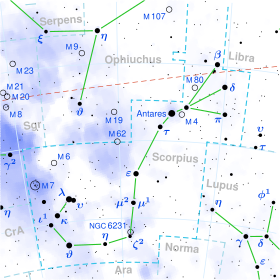Lambda Scorpii
| Observation data J2000
| ||
|---|---|---|
| Constellation | Scorpius | |
Pronunciation
|
/ˈʃɔːlə/[1][2] | |
| Right ascension | 17h 33m 36.520s[3] | |
| Declination | −37° 06′ 13.76″[3] | |
| Apparent magnitude (V) | 1.62 + 14.9 + 12.0[3][4] | |
| Characteristics | ||
| Spectral type | B1.5IV + B2IV[5][6] | |
| U−B color index | −0.880[7] | |
| B−V color index | −0.240[7] | |
| Variable type | Beta Cephei (A)[8] | |
| Absolute magnitude (MV) | −3.70[10] | |
Inclination (i) | 77.2° | |
Semi-amplitude (K1)(primary) | 39.3 km/s | |
| Details | ||
| λ Sco Aa | ||
Rotational velocity (v sin i) | 150[8] km/s | |
| λ Sco B | ||
| Mass | 8.1[5] M☉ | |
| Radius | 4.7±1.0[8] R☉ | |
| Surface gravity (log g) | 4.0[6] cgs | |
| Temperature | 25,000±1,000[8] K | |
| λ Sco Ab | ||
| Mass | 1.8[5] M☉ | |
| J17336-3706A/B/C | ||
| Database references | ||
| SIMBAD | data | |
Lambda Scorpii is a triple
Nomenclature
λ Scorpii (Latinised to Lambda Scorpii) is the star system's Bayer designation.
It bore the traditional name Shaula, which comes from the Arabic الشولاء al-šawlā´ meaning 'the raised [tail]', as it is found in the tail of Scorpius, the scorpion. In 2016, the International Astronomical Union organized a Working Group on Star Names (WGSN)[12] to catalog and standardize proper names for stars. The WGSN's first bulletin of July 2016[13] included a table of the first two batches of names approved by the WGSN, which included Shaula for the star λ Scorpii Aa.
In Indian Astronomy it is called MulA Nakshathram. Mūla ("root") (Devanagari मूल/मूळ) (Tamil: மூலம்) is the 19th nakshatra or "lunar mansion" in Vedic astrology. The symbol of Mula is a bunch of roots tied together (reticulated roots) or an 'elephant goad' (ankusha).[citation needed]
In
Together with υ Scorpii (Lesath), Shaula is listed in the Babylonian compendium MUL.APIN as dSharur4 u dShargaz, meaning "Sharur and Shargaz".[16]
In Coptic, they were called Minamref.[17]
The indigenous
Properties

Lambda Scorpii is located some 570 light-years away from the Sun.
Spectroscopic and
A 15th-
In culture
Shaula appears on the flag of Brazil, symbolizing the state of Rio Grande do Norte.
References
- ISBN 978-1-931559-44-7.
- ^ "IAU Catalog of Star Names". Retrieved 28 July 2016.
- ^ S2CID 18759600.
- doi:10.1086/374771.
- ^ S2CID 13971499.
- ^ hdl:2066/60554.
- ^ S2CID 122459090.
- ^ S2CID 56403146.
- S2CID 119231169.
- .
- ^ S2CID 119047709.
- ^ "IAU Working Group on Star Names (WGSN)". Retrieved 22 May 2016.
- ^ "Bulletin of the IAU Working Group on Star Names, No. 1" (PDF). Retrieved 28 July 2016.
- ISBN 978-986-7332-25-7.
- ^ (in Chinese) 香港太空館 - 研究資源 - 亮星中英對照表 Archived 2008-10-25 at the Wayback Machine, Hong Kong Space Museum. Accessed on line November 23, 2010.
- Bibcode:1998JBAA..108....9R.
- ISBN 978-0-486-23673-5.
- S2CID 118454721.
- Bibcode:1857PPIVT...2..137S.
- ^ "MAST: Barbara A. Mikulski Archive for Space Telescopes". Space Telescope Science Institute. Retrieved 8 December 2021.
- S2CID 244398875. Gaia DR3 record for this source at VizieR.
- S2CID 244398875. Gaia DR3 record for this source at VizieR.

